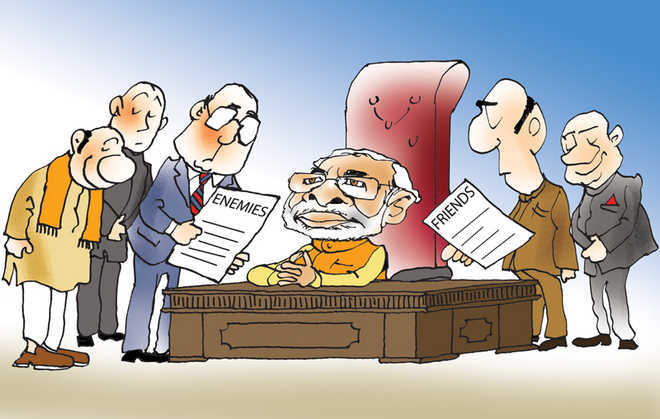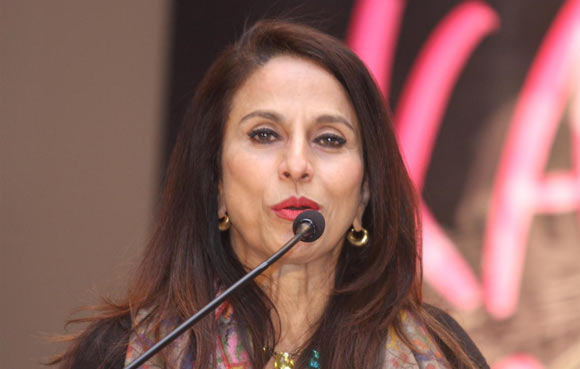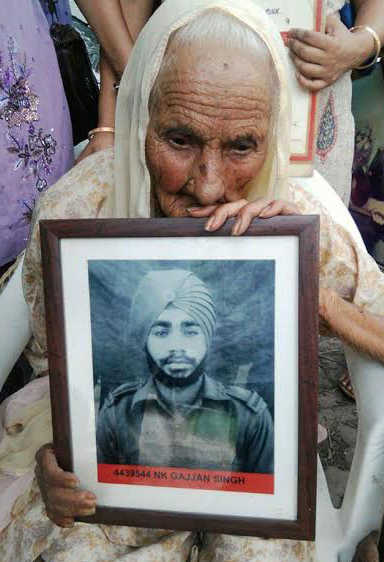Someone desperately needs to stand up in the PMO and tell the one man that matters that he has no clothes, or better still, whatever he had on is fast disappearing thanks to his myopic advisors.
The decision taken day before to appoint Lt General Bipin Rawat as the next COAS by going over the heads of two extremely fine, competent Army Commanders must rank as one of the most absurd policy decisions taken by this government. To even suggest that this is not a political decision and is based on some deep selection nonsense, is to insult the intelligence of the people of this country. During the run up to the dark days of October/November 1962, similar political interference in senior appointments had reduced the Army into a virtual non-combatant force. Now, half a century later, instead of having learnt our lessons, we are doing exactly the same thing all over again… wake up Mr Modi, surely you don’t want history to remember you as a clone of Nehru who in his arrogance had allowed the Chinese to deliver a stinging slap from which the country could never quite recover…
By all accounts, General Bipin Rawat is a fine officer, and this article in no way is aimed at belittling him. This is about the Institution, which is the Armed Forces of India, who can in no way afford to be mired in politics. You want an apolitical army, then you must have a political and bureaucratic set up which respects the armed forces… which today is not the case. It is no secret that in the contemporary set up the entire security network is being run by cops and super cops, who together spare no opportunity to rub the military’s nose in the dust. It’s hardly surprising that one of the jokes going around on social media after the Chief’s appointment was announced stated that ‘thank god the powers that be didn’t take some DIG from the BSF and make him the COAS’.
Namo launched his election campaign from Rewari using the massive ex-Servicemen platform with a host of retired senior officers standing shoulder to shoulder by his side. Promises had been made that the Armed Forces would be given their due at last and past injustices would be addressed, be it the general state of unpreparedness due to endless defence scams or OROP that was the natural right of the Indian soldier. As the country responded to Namo and the BJP swept to power with a thumping majority, many saw it as the beginning of a new era. An era where there would be zero-tolerance towards corruption, where the country would once again reign supreme and the soldier and the farmer would once again be the bedrock around whom modern India would build itself. This alas has not happened, and there is already a feeling of betrayal that will be hard to undo later.
The tenure of the UPA Government had been rocked by defence scandals and towards that end certain elements in and around the PMO with the help of a former COAS had gone about creating the ‘Line of Succession’ in the Army. The end of the UPAs tenure also coincided with the end of General Bikram Singh’s term as the Army Chief, and it was expected that Namo would in the interest of the Armed Forces, take a fresh look at the appointment of the new chief. Despite the fact that the BJP leader, Subramanian Swamy, took it upon himself to write to the Commander-in-Chief, President Pranab Mukherjee and point out to him the obvious deficiencies and limitations of the new man, the BJP chose to be a mute spectator on the grounds that the UPA could appoint a new chief 3-months in advance as that was the accepted norm.
General Bikram Singh’s forced elevation to the top job despite some extremely serious cases against him had seen the untimely end of some very competent and fine officers, people the Army looked up to. His successor, General Suhag, an officer who had even failed to qualify for the Staff College and who like Bikram had serious cases against him as well, not only made it to the top job but proved to be far from the ideal choice. Seen only hovering around and pulling chairs for his immediate bosses (first Jaitley and then Parrikar), the combined tenure of Bikram and Suhag was looked at by most army officers as the dark age which would finally come to an end in December 2016 with the retirement of Dalbir Suhag. The biggest casualty during this period had been self respect, for unless an Army is led by Generals, it is no army at all.
For months now, there was a growing feeling of excitement that finally the ‘Line of succession’ would come to an end and the extremely competent and respected General, Pravin Bakshi would take over the Army, or what was left of it. ‘Frankly, we’ve just ridden out this period… only in the hope that there would be light at the end of the tunnel’, said a mid-ranking officer who had a close-up view of the going-ons in Army HQ, ‘It’s not only dog eat dog, its now every man for himself in the top echelons of the Army. The officers one looked up to, they just kept getting sidelined and the one’s with feet of clay seem to go from strength to strength! If politicians wanted General officers to mirror them in their behavior, they sure have succeeded.’
For months now there had been dark whispers about the cynical games that were being played in the corridors of power. The ADGPI, a Major General ranked-officer who heads the Army’s publicity cell, had been surreptitiously telling journalists that Bakshi, the Eastern Army commander, was an “Armoured Corps’ officer who had no clue about Counter Insurgency and would therefore be a lousy choice for the chiefs job. Anonymous letters had also begun to appear accusing Bakshi of using up his entire budget allocation of 100 crores.’ Unconfirmed reports also suggest that Bakshi was thoroughly investigated but the dirty tricks department just could not find any dirt on him.
It was also a well-known fact that the VCOAS, Lt General Bipin Rawat was a favourite of the NSA, Ajit Doval and despite his lack of seniority, a candidate for the top job. Adding to Rawat’s chances was the fact that not only did he have Suhag’s backing, the outgoing COAS was quite desperate to have him take over. ‘The key,’ says another senior officer on condition of anonymity, ‘lies in Dimapur, the HQ of the infamous 3 Corps. The two cases pertaining to the Johat Dacoity Case and the killing of three Manipuri boys, hangs like an albatross around Suhag’s neck. Ever since he moved from Dimapur to Calcutta and then Delhi, between Bikram Singh and Suhag, they ensured their handpicked guys were sent to 3 Corps. Rawat not only commanded this formation, the current GOC, Abhay Krishna, a key Suhag loyalist, is currently commanding the Dimapur formation and quite likely to take over from Bipin Rawat three years down the line as COAS. Your ‘Line of Succession’ is very much alive and kicking.’
If indeed Bakshi was found wanting for some reason, why go after Lt General PM Hariz, who is the next senior and with an equally outstanding record of service. Being a Mechanised Infantry officer or an Armoured Corps officer has no meaning for after an officer has reached a Corps Commanders level, the arm he is from has no meaning. To boot, Hariz is a Muslim and even though he is from Kerala, the government needed to have solid reasons to risk a backlash in the coming UP elections.
The spin-doctors would have us believe that the decision to appoint Rawat was based on merit and what apparently swung the decision in his favour was his experience of CI Ops. For those even vaguely familiar with the ways the army functions, this is laughable. Pravin Bakshi as the Eastern Army Commander is fighting Insurgency in Manipur all the time, and if anyone says that is less complicated than fighting in the Valley, then he is either talking through his hat or is just lying through his teeth. Besides, Bakshi also commanded 9 Corps which was as involved in fighting insurgency as 16 Corps during that time – in fact, any scrutiny of public records will show the formation under Bakshi had more ‘kills’ than the Nagrota based formation, if that is any criteria to go by. Further, as Chief of Staff Northern Command, the man probably had a deeper understanding of the problem than Bipin Rawat, who though he commanded the Baramula Division, was not deployed in a CI role.
If CI Ops in Kashmir were indeed the key, then another factor comes into play – which is Lt General BS Negi who is currently the Central Army Commander and the former 14 Corps Commander. This officer, who not only commanded a battalion in Siachen, has been in and out of the Valley and his operational record would have in all probability, outshone Bipin Rawat’s. To top it off, Negi is perhaps the most decorated officer in the Indian army. And if the so-called surgical strike in Myanmar has to be credited to Rawat last year, maybe he needed to answer why first 8 men of Assam Rifles and then 22 from the Dogras got ambushed and killed under his watch in the first place.
It may be the prerogative of the government to appoint whoever they feel meets their requirement, but the last few times the government interfered, they had egg all over their face. Nehru’s backing BM Kaul led to Thimayya and Thorat being sidelined and Thapar being made chief or more recently, Mrs Gandhi edging out the outspoken General Sinha in favour of General Vaidya, a move that perhaps eventually cost her (and him) their lives.
And while we are still hovering around the subject of 1962, it is interesting to note the similarities in the role being played by Ajit Doval and BN Mullik. Both had the ear of their respective PMs who trusted them blindly… need one say more?
The Government of India, having taken what any sane observer would tell them (due respect to General’s Atta Hasnain and Ravi Dastane who seem intent on sucking up in the hope of getting Governor’s jobs) is a stupid and insane decision, must find ways of rectifying the error. Perhaps the key itself lies in the hands of General Bipin Rawat, who can perhaps immortalize himself in military folklore by telling the Government of India it has made a mistake, for dividing the army into small factions isn’t going to do the institution that he is a part of any good. The General today has a choice – he can be remembered as the man who was made the chief by stabbing his comrades in the back; or he can be the son of a soldier (who was also the Deputy Chief) who puts his country, his army ahead of himself. The choice is his…
Postscript
Contrary to what Lt Gen Atta Hasnain has put out in his rather surprising endorsement of Bipin Rawat as the next COAS, it is well known that as Commander 5 Sector and later as GOC 19 Division, the officer’s performance was nothing exceptional. It is all very well to say that Army appointments must not be debated, but if they are politically motivated, as this one surely is, then the officer will sooner or later come under severe scrutiny. For example, it has also been rumoured that even as a cadet, Bipin Rawat superseded four other GCs who were ahead of him in the order of merit when he was awarded the Sword of Honour. Perhaps then too it was a coincidence that the Commandant of the IMA was a Gen Rawat, who was also from the same Regiment as his own father…
I say ‘surprising endorsement’ by some senior officers because surely they too must realise that by playing such dangerous games, the GOI is opening up the highest ranks to politics. Whatever be the merit and demerit of seniority at this level, it certainly does not require ‘canvasing’ to be a necessary part of the selection process. Just to get a few brownie points from Namo, they really should think twice before endorsing such a stupid decision. There are other ways to get noticed and get your governorships! I also recommend people read what Gen Vijay Oberoi has to say on the subject
Shobha Rajadhyaksha, also known as
Shobhaa De (born 7 January 1948), is an
Indian columnist and novelis





































































